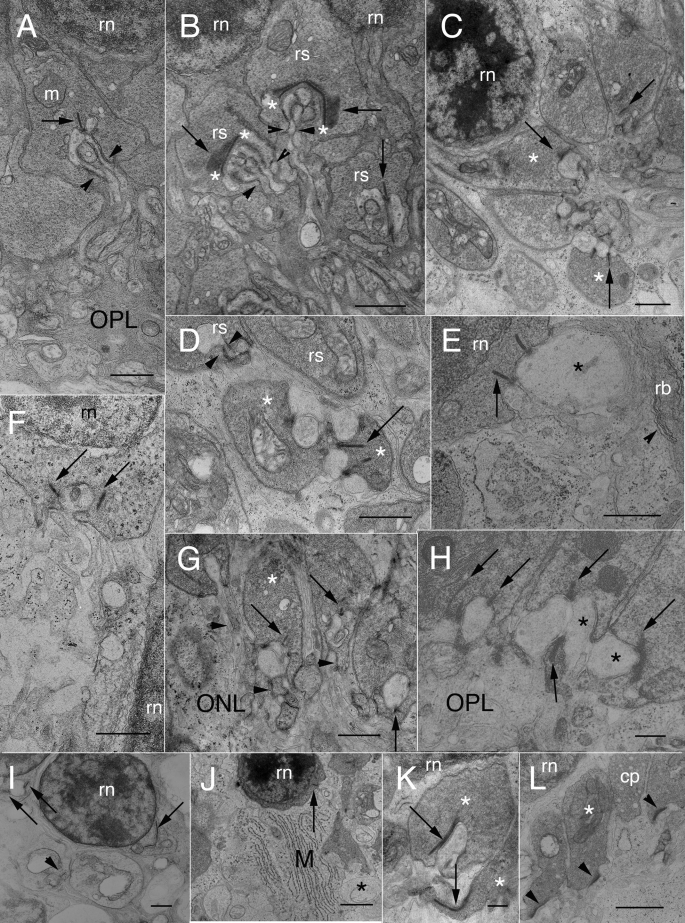Figure 4.
Electron micrographs of normal and detached cat retina. A: A rod spherule lies between the OPL neuropil and the innermost tier of rod cell nuclei (rn). The presynaptic cytoplasm is crowded with a uniform population of 35–45 μm light cored synaptic vesicles. A synaptic ribbon (arrows) opposes fine, invaginating HCat telodendria and rod bipolar dendrites. The innervating processes pass through the hilus (arrowheads) to enter the invagination. Mitochondria (m) typically lie near the synapse. Scale bar represents 0.8 μm. B: In normal cat retina, 3 neighboring rod spherules (rs) show details of presynaptic and postsynaptic architecture. In two rod spherules, the synaptic ribbon (arrows) is seen chiefly en face. In addition to the dense presynaptic populations of synaptic vesicles, the upper spherule also contains profiles of ser cisternae or endosomes, two of which lie near a mitochondrion. At the base of the synaptic ribbons, asterisks (*) demarcate the ends of the particularly electron-dense arciform densities. HCat telodendria and rod bipolar (RB) dendrites pass through a basal hilus to enter their respective synaptic invaginations (arrowheads). The rod nucleus is labeled (rn). Scale bar represents 0.8 μm. C: This area of the OPL in 7 day detached cat retina is enlarged from Figure 3C. Although these spherules lie in their usual location and show little evidence of retraction, their ultrastructure is abnormal. The spherules themselves are turned in such a way that their basal synaptic surfaces, instead of facing the OPL, face each other around a cluster of postsynaptic processes. Two of the spherules (*) have shallow invaginations without evidence of any hilus. Swollen HCat telodendria contact these spherules in “open” configurations. Synaptic ribbons (arrows) are seen in three spherules. All the spherules in this location are filled with synaptic vesicles. Interestingly, the two profiles of a synaptic ribbon in the bottom spherule have arciform densities that appear to project as synaptic ridges between apposing horizontal cell (HC) lateral elements. Scale bar represents 0.75 μm. D: Several retracting rod spherules in 7-day detached cat retina lie in the lower outer nuclear layer (ONL) enveloped by Müller cell cytoplasm. The uppermost spherule is invaginated; one HC lobe is visible as is the hilus (arrowheads) through which the postsynaptic processes pass. Two subjacent spherules (*) make open contacts with swollen HC axon telodendria. One contains a synaptic ribbon (arrow) that shares a HC lobe with a neighboring ribbon. Both ribbons appear to extend from arciform densities that project outward as synaptic ridges. Spherules above and below them lack synaptic ribbons in this plane of section, but have multiple mitochondria. Synaptic vesicles populate all of the terminals. Scale bar represents 0.8 μm. E: A section through basal perinuclear cytoplasm of a rod soma in the mid-ONL of 7-day detached cat retina shows numerous synaptic vesicles and two cross-sections of synaptic ribbons. One to the left is presynaptic to two vesicle-containing HC processes, one of which (*) is very swollen and also postsynaptic to the other ribbon, both in open, non-invaginated configurations. Subjacent Müller cell cytoplasm has distended rer cisternae and numerous polysomes. Scale bar represents 0.8 μm. F: Two rod nuclei (rn) lie in the mid- to lower ONL of cat retina detached for 7 days. The shallow perinuclear synaptic invagination of the upper cell body contains two pale lateral elements and a small, dark central element. Arrows point to cross-sections of synaptic ribbons (perhaps the same one) that lack arciform densities and have only a few synaptic vesicles lying near them. Presynaptic cytoplasm also contains a few endosomes and scattered polysomes. Scale bar represents 0.6 μm. G: Four partially retracted spherules lie in the inner ONL of a 7-day detached retina. All have their synaptic surfaces facing the inner retina. These terminals are filled with synaptic vesicles and have synaptic ribbons (arrows) presynaptic to electron-lucent HCat telodendria. One of the spherules (*) makes an open contact with postsynaptic processes and lacks the normal synaptic invagination. RB outgrowths (arrowheads) lie near these synapses but do not enter the invaginations. Scale bar represents 0.8 μm. H: Three rod spherules in 7-day detached cat retina remain at the OPL but nevertheless lack typical synaptic invaginations. Presynaptic cytoplasm is crowded with synaptic vesicles. Synaptic ribbons (arrows) appose swollen and electron-lucent HCat telodendria in open configurations. The HCat processes innervating two adjacent spherules (*) directly appose each other. Scale bar represents 0.3 μm. I: Two rod nuclei (rn) in 28-day detached cat retina front on the OPL. Both contain a perinuclear basal invagination with synaptic ribbons (arrows). Subjacent spherules lie in their normal position; one also contains a synaptic ribbon (arrowhead). The density of the synaptic vesicle population is abnormally low. Scale bar represents 0.6 μm. J: Low power survey of the inner ONL in cat retina detached for 7 days. Several retracting rod spherules are loosely packed along with a rod soma (rn) containing a cross-section of an indistinct synaptic ribbon (arrow) that apposes an HCat process without evidence of any invagination, arciform density, or RB dendritic contact. Only two or three synaptic vesicles associate with the ribbon in this plane of section. Müller cell cytoplasm (M) enshrouding these structures contains prominent arrays of parallel rer cisternae. Asterisk (*) indicates swollen HCat process. Scale bar represents 1.5 μm. K: Two retracting spherules (*) in cat retina detached for 7 days contain synaptic ribbons (arrows) that lie almost parallel to their presynaptic membranes. Arciform densities are not discernible. The upper spherule is invaginated, the lower is not. Both are crowded with synaptic vesicles. Post-synaptic HC lateral elements contain flattened light cored vesicles of various sizes. Scale bar represents 0.3 μm. L: In 7-day detached cat retina, three retracting rod spherules in the lower ONL are surrounded by Müller cell cytoplasm (M). All three show basal densifications (arrowheads) but no ribbons or other structural characteristics of rod synapses. The presynaptic cytoplasm contains vesicles, one or more mitochondria (*), endosomes, and scattered polysomes. The edge of a cone pedicle (cp) is seen. Scale bar represents 1.2 μm.

